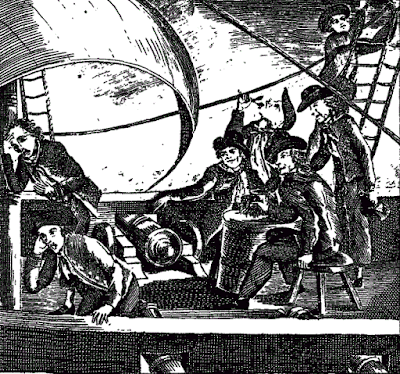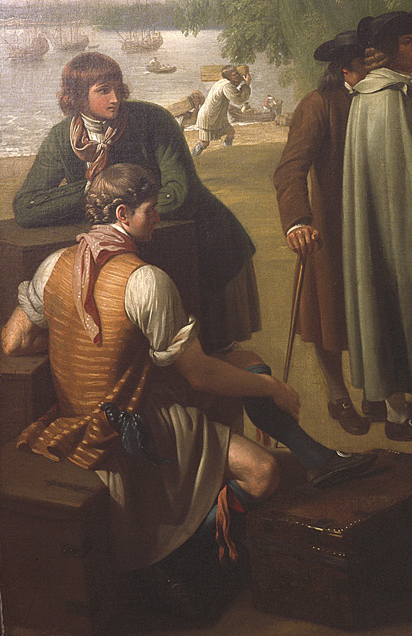"Jack the Guinea Pig," C. Sheppard, 1790, Bodleian Ballads Online.
The author of "Jack the Guinea Pig" wrote a cheerful and peppy ballad of the joys of life at sea, and how hardened sailors can revel in their difficulties. To accompany this piece, the prolific engraver C. Sheppard illustrated a party of tars drinking atop a rum or water cask, taking delight in the suffering of the nearby landsmen. As the ballad writer put it:
When we sail with a freshening breeze,
And landsmen all grow sick, sir,
The sailor lolls with his mind at ease,
And the song and the can go quick, sir.
Laughing here,
Quaffing there,
Steadily, readily,
Cheerily, merrily,
Still from care and thinking free, Is a sailor's life at sea.
Sure enough, these landsmen are having a miserable time.
The two landsmen in the left of the frame are without waistcoats. One wears a cocked hat, the other is hatless. The fellow in the background wears an unremarkable jacket and trousers that end at about the bottom of the calf with white stockings and shoes. His mate in the foreground wears a single breasted jacket with white buttons (possibly metal) and turned back cuffs with dark breeches or trousers.
To the right is a party of sailors on deck. Those that we can see have trousers. The sitting tars has close fitting trousers that show off his calves and a jacket with a single vent at the back and closed, scalloped mariner's cuffs. Though difficult to be certain, I think he is wearing a neckcloth around his neck. Certainly the other three wear neckcloths, but at least two of them are without waistcoats. All of them wear jackets and round hats with wider brims. Interestingly enough, the crowns of their round hats are both rounded and conical, showing a wider variety in round hat headgear than I've seen in any other single image.
Climbing aloft on the ratlines is a sailor on watch, wearing the same as his mates: a round hat, jacket, shirt without waistcoat, and dark trousers.
The two landsmen in the left of the frame are without waistcoats. One wears a cocked hat, the other is hatless. The fellow in the background wears an unremarkable jacket and trousers that end at about the bottom of the calf with white stockings and shoes. His mate in the foreground wears a single breasted jacket with white buttons (possibly metal) and turned back cuffs with dark breeches or trousers.
To the right is a party of sailors on deck. Those that we can see have trousers. The sitting tars has close fitting trousers that show off his calves and a jacket with a single vent at the back and closed, scalloped mariner's cuffs. Though difficult to be certain, I think he is wearing a neckcloth around his neck. Certainly the other three wear neckcloths, but at least two of them are without waistcoats. All of them wear jackets and round hats with wider brims. Interestingly enough, the crowns of their round hats are both rounded and conical, showing a wider variety in round hat headgear than I've seen in any other single image.
Climbing aloft on the ratlines is a sailor on watch, wearing the same as his mates: a round hat, jacket, shirt without waistcoat, and dark trousers.

















